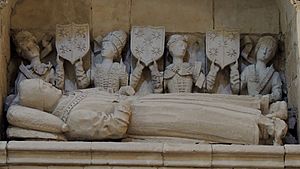Juan Rodríguez de Fonseca facts for kids
Quick facts for kids Juan Rodríguez de Fonseca |
|
|---|---|
| Archbishop of Rossano | |
 |
|
| Archdiocese | Rossano |
| See | Rossano |
| Appointed | 20 June 1519 |
| Reign ended | 12 November 1524 |
| Predecessor | Bernardino López de Carvajal |
| Successor | Vincenzo Pimpinella |
| Other posts | Bishop of Burgos |
| Personal details | |
| Born | 1451 Zamora |
| Died | 12 November 1524 (aged 72–73) |
| Denomination | Roman Catholic |
| Previous post |
|
Juan Rodríguez de Fonseca (1451–1524) was an important Spanish archbishop. He was also a courtier (someone who advises a king or queen) and a government official. His role as a royal chaplain to Queen Isabella helped him become a powerful advisor to the Catholic Monarchs, Ferdinand and Isabella.
He was in charge of the Casa de Contratación. This was an agency that managed trips to the New World for the Spanish crown. Later, he became the president of the Council of the Indies when it was created in 1521. He helped organize many important Spanish expeditions. These included the voyages by Christopher Columbus and Magellan's circumnavigation of the Earth.
Contents
Early Life and Education
Juan Rodríguez de Fonseca was born in 1451 in Toro, a town in Spain. His family was important and had moved to Spain from Portugal about a hundred years earlier. His father was Fernando de Fonseca. Juan and his brother, Alonso de Fonseca y Acevedo, were expected to have careers in the Church.
His family supported Isabella of Castile in her claim to the throne. Because of their help, Queen Isabella recommended Juan to her confessor, a monk named Hernando de Talavera. This monk taught Juan about theology and other subjects.
Rodríguez de Fonseca became a priest on April 6, 1493. He quickly became a canon and then the Dean of the Seville cathedral. He also served as a Vicar General for the archdiocese.
Managing the New World
The Spanish rulers trusted Juan Rodríguez de Fonseca to help set up the new colonies. He started by organizing Columbus’ second voyage in 1493. From then on, he had more and more say in Spain's plans for its colonies. He became like the kingdom's main minister for colonial affairs.
Rodríguez de Fonseca had disagreements with Columbus. He felt Columbus was acting too independently from the king and queen. In 1499, Queen Isabella, influenced by Fonseca, removed Columbus as governor of the new lands. After this, Fonseca began planning and organizing many other voyages. These trips were led by captains like Alonso de Ojeda and Vicente Yáñez Pinzón. These voyages helped Spain discover more lands and learn more about the islands and mainland of what became known as the New World.
In 1503, Rodríguez de Fonseca helped create an important new organization called the Casa de Contratación. This agency took on big responsibilities for managing the new settlements overseas. He also played a key role in the development of the Council of the Indies. This council was officially created in 1524 and became the most important royal group for governing the new colonies. After Queen Isabella died in 1504, King Ferdinand gave Fonseca almost complete control over the overseas colonies.
Rodríguez de Fonseca was named Bishop of several places over time. These included Badajoz (1495), Córdoba (1499), Palencia (1504), and finally Burgos (1514). Burgos was one of the richest church areas in Spain. In 1519, he was also named Archbishop of Rossano in Italy. King Ferdinand even asked the Pope to give Rodríguez a new title, Patriarch of the West Indies. This title would have made him a cardinal, but it was not created until after Fonseca's death.
After King Ferdinand died in 1516, Rodríguez de Fonseca continued his work under the new ruler, King Charles I. However, he did not have the same level of trust he had with the previous monarchs. He finished his career by supporting and organizing the famous voyage of Ferdinand Magellan. This was the first voyage to sail all the way around the world.
Challenges and Critics
Over his long career, Juan Rodríguez de Fonseca made many enemies. One of his most notable critics was the Dominican bishop, Bartolomé de las Casas. Las Casas was known as the "Protector of the Indians." He spoke out against Fonseca because he felt Fonseca did not care enough about the harsh treatment of native people by Spanish settlers in the new lands. Fonseca also had disagreements with Hernán Cortés, who conquered Mexico. This led to Cortés being removed from his position in 1523.
Death and Burial
Juan Rodríguez de Fonseca died in Burgos on March 4, 1524. He was buried at the Church of Santa María la Mayor in Coca, Spain. His tomb can still be seen there today.
See also
 In Spanish: Juan Rodríguez de Fonseca para niños
In Spanish: Juan Rodríguez de Fonseca para niños

